On Bonfire Night, Celtic Park hosted a great game between Celtic and RB Leipzig.
Leipzig were the favourites going into the game.
However, Celtic won 3-1 against Bundesliga side Leipzig in the UEFA Champions League on Matchday Four.
This win left Celtic with seven points from four games, keeping them in the race for the knockout stages and boosting morale.
Celtic beat RB Leipzig 3-1 in the UEFA Champions League on Matchday 4.
It was a historic win for the Scottish club,
and this tactical analysis will show how well they are doing under Brendan Rodgers’s tactics.
This analysis will examine how Celtic played, who did well, and what tactics they used to beat one of Germany’s top clubs.
Celtic came from behind after Christoph Baumgartner‘s header to win the match thanks to two goals from Nicolas Kuhn and one from Reo Hatate.
Rodgers’s side used possession, disciplined pressing and a balanced attack to neutralise Leipzig’s threat and capitalise on key moments.
Celtic Vs RB Leipzig Lineup
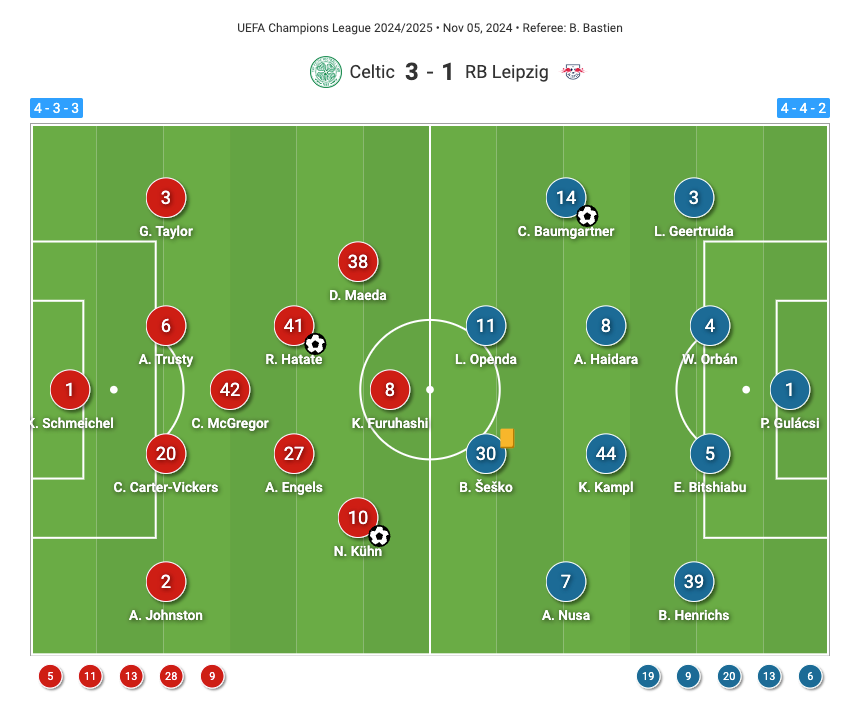
Brendan Rodgers used a 4-1-4-1 formation during the game.
This helped Celtic manage the midfield better than a more aggressive 4-3-3 and cope with Leipzig’s pressing without losing attacking depth.
Schmeichel was in goal, with Johnston and Taylor as full-backs.
Carter-Vickers and Trusty played in central defence, while McGregor was the lone pivot in midfield, supported by Hatate and Engels.
Maeda and Kuhn were wingers, with Furuhashi as the striker.
The 4-1-4-1 formation let Celtic play defensively in a compact way while still attacking.
The defence kept a good shape, with Trusty and Carter-Vickers getting lots of interceptions and clearances.
McGregor linked defence and attack by providing a base for Engels and Hatate to push forward.
RB Leipzig played a 4-4-2 formation, with a focus on defence and attack.
Marco Rose picked Peter Gulácsi as a goalkeeper because he is experienced and calm.
Two centre-backs, Castello Lukeba and Willi Orbán, were responsible for defending against Celtic’s attack.
Full-backs Benjamin Henrichs and Lutsharel Geertruida helped defend and attack.
Henrichs could also overlap on the right.
Rose picked two midfielders, Amadou Haidara and Kevin Kampl, who work hard defensively and pass the ball well.
Christoph Baumgartner and Antonio Nusa were positioned on the wings to provide width and creativity, with Baumgartner being a goal-scoring threat.
Up front, Loïs Openda and Benjamin Sesko were expected to combine speed, physicality, and finishing ability.
Celtic’s Possession & Counterpressing
Celtic dominated the game.
They controlled the tempo and had most of the possession, holding 60% of the ball.
Leipzig are known for pressing and quick transitions.
Celtic completed almost 700 passes, showing good control of the ball.
The teams were evenly matched from the start.
Leipzig scored first, but Celtic equalised with a long-range effort from Kuhn and added a second goal just before half-time.
In the second half, Celtic kept up the pressure and Hatate scored from a mistake by Leipzig goalkeeper Peter Gulacsi.
Celtic were efficient in front of the goal despite having few shots on target.
Celtic’s approach to possession and pressing was effective against a team known for its high-intensity press.
Celtic disrupted Leipzig’s build-up play and forced turnovers in dangerous areas by maintaining a high line and pressing aggressively.
Celtic High Regains Map
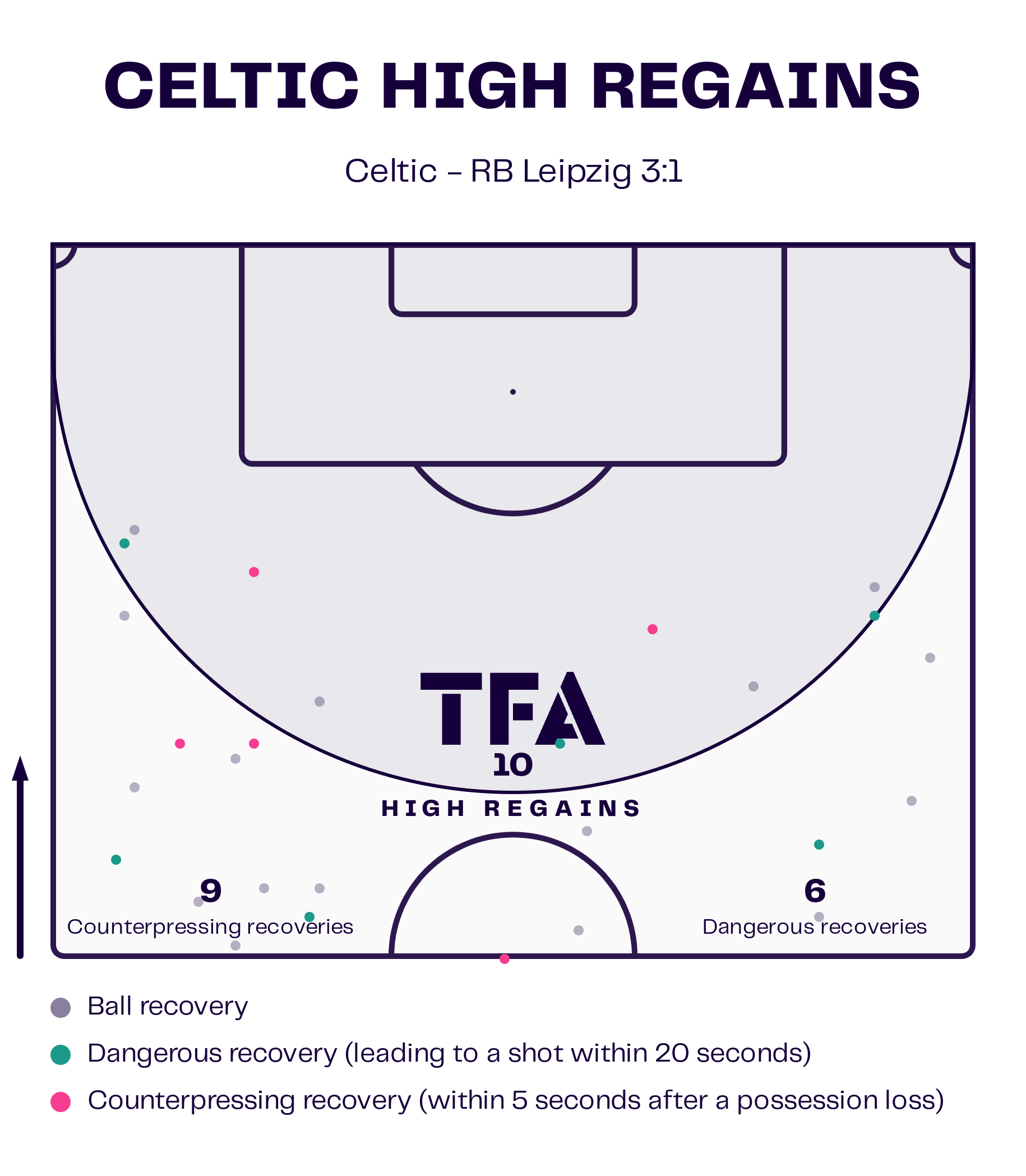
Celtic’s counter-pressing helped them win the ball back quickly and attack.
Rodgers told his team to be patient with the ball and not to panic under pressure from Leipzig.
Celtic built from the back, rather than using long balls.
When Leipzig committed players forward, Celtic took advantage by exploiting the space left behind.
Despite holding possession, the team quickly transitioned from defence to attack thanks to Kuhn and Maeda’s wide positioning.
The wingers gave Celtic space to bypass Leipzig’s midfield and create space for forward runs.
Kyogo Furuhashi pressed high and created space for midfield runners.
Celtic moved quickly and effectively from defence to attack.
Kuhn and Maeda made space for Hatate and Engels to attack Leipzig’s defence.
Furuhashi’s movement created space for midfield runners.
Celtic’s ability to switch quickly from defence to attack was key to their success.
It allowed them to bypass Leipzig’s press and expose gaps in their defensive setup.
Celtic’s defence was solid throughout the match.
The backline, led by Trusty and Carter-Vickers, kept Leipzig from scoring.
Johnston and Taylor provided width at the back, while McGregor helped to protect the defence.
Celtic Defensive Territory Map
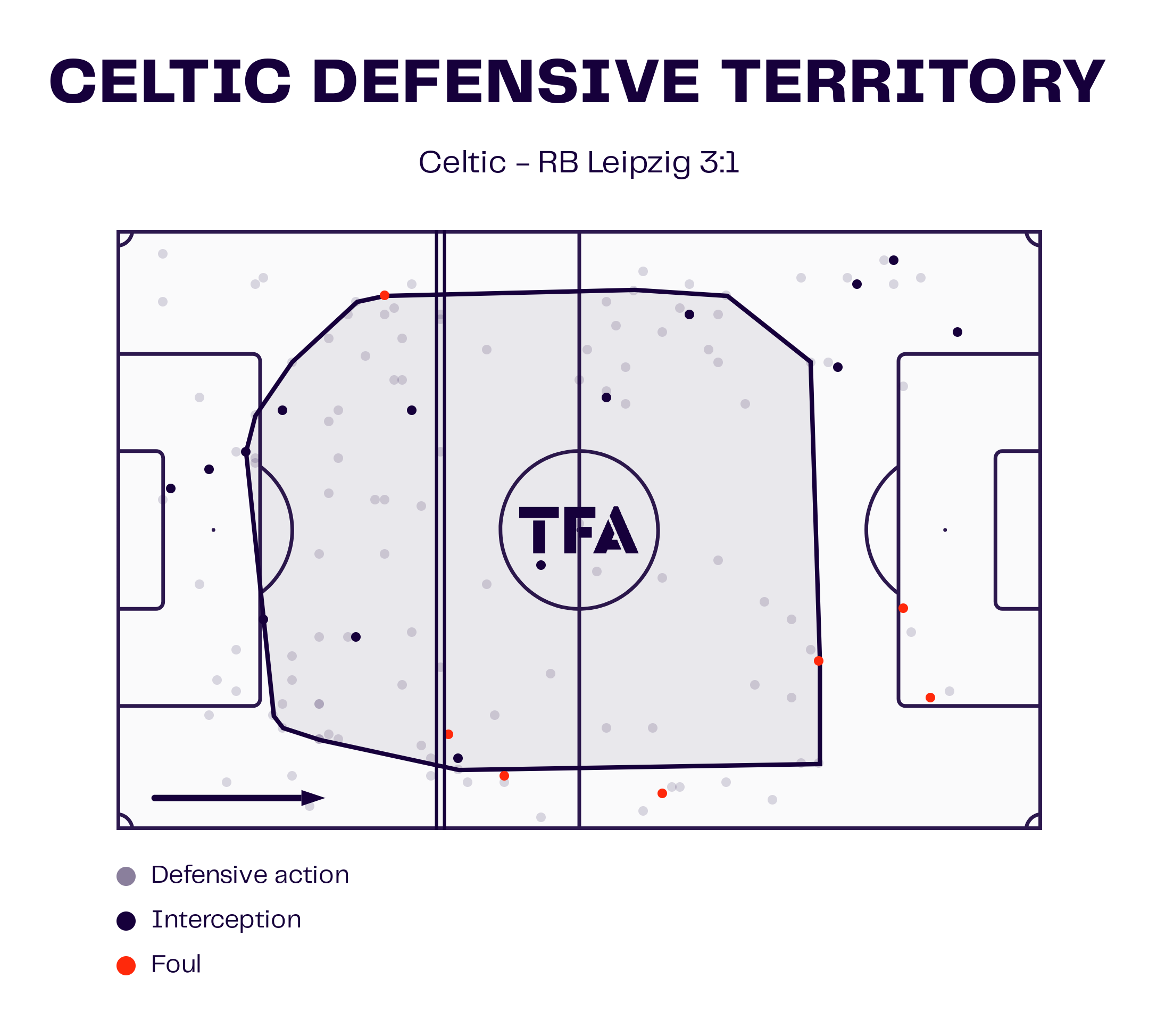
After taking the lead, Celtic controlled the game well.
They kept a strong defence and Leipzig had little space to create chances.
Celtic held onto their lead and saw the game out comfortably.
RB Leipzig’s Issues
RB Leipzig has struggled this season, with inconsistent performances and disappointing results.
They seem to lack team chemistry.
The squad has changed a lot in recent years.
New players arrive each season, including young talents who need time to adapt.
Players coming and going have made it hard for the team to stick together.
There are no smooth transitions from defence to attack.
The team has struggled to play as a unit in both the Bundesliga and the UEFA Champions League.
They have often lost control of games in critical moments.
Leipzig have struggled defensively, costing them points in both domestic and European competitions.
They have the talent to field a solid backline, but errors and lapses in concentration have let opponents score.
Leipzig struggled to handle Dortmund‘s quick counterattacks, allowing them too much space in the final third in their recent Bundesliga loss.
Leipzig also conceded several goals in this match against Celtic in the Champions League.
The team’s defensive solidity is lacking because they haven’t been able to establish a consistent backline.
Injuries and tactical changes have prevented players like Willi Orbán and Castello Lukeba from forming a reliable partnership.
RB Leipzig Territory Map
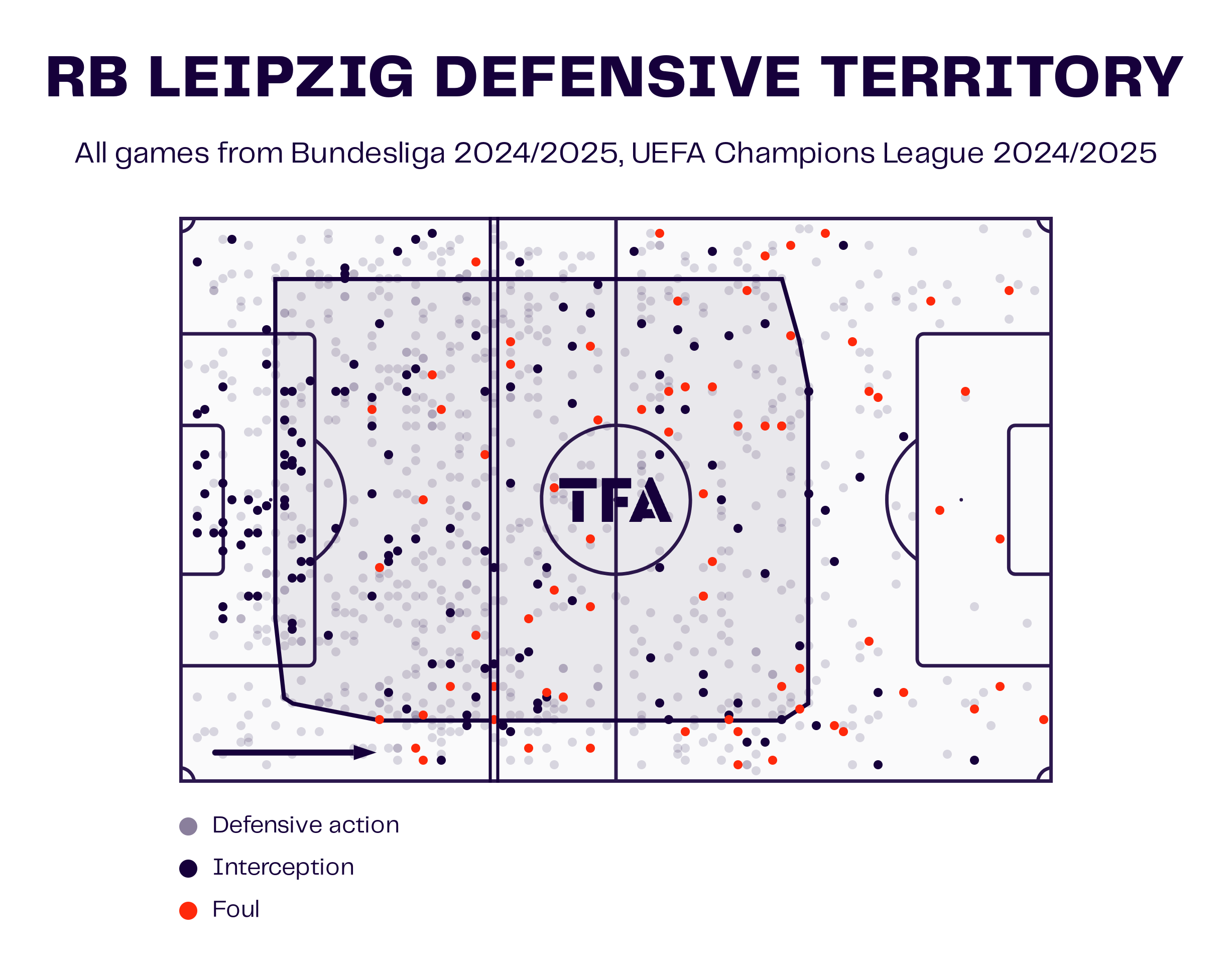
The team’s high-pressing style is effective, but if the initial press is bypassed, it leaves them vulnerable to fast transitions.
Leipzig’s defence often leaves too much space for quick opponents to exploit.
Experienced players are a crucial issue for Leipzig.
Key figures like Peter Gulácsi, Kevin Kampl and Willi Orbán will help the team as younger players adjust to top-level competition.
However, these veterans have not played well.
Gulácsi has made mistakes in goal, including the one against Celtic that led to a goal.
Peter Gulácsi Shots Faced Map
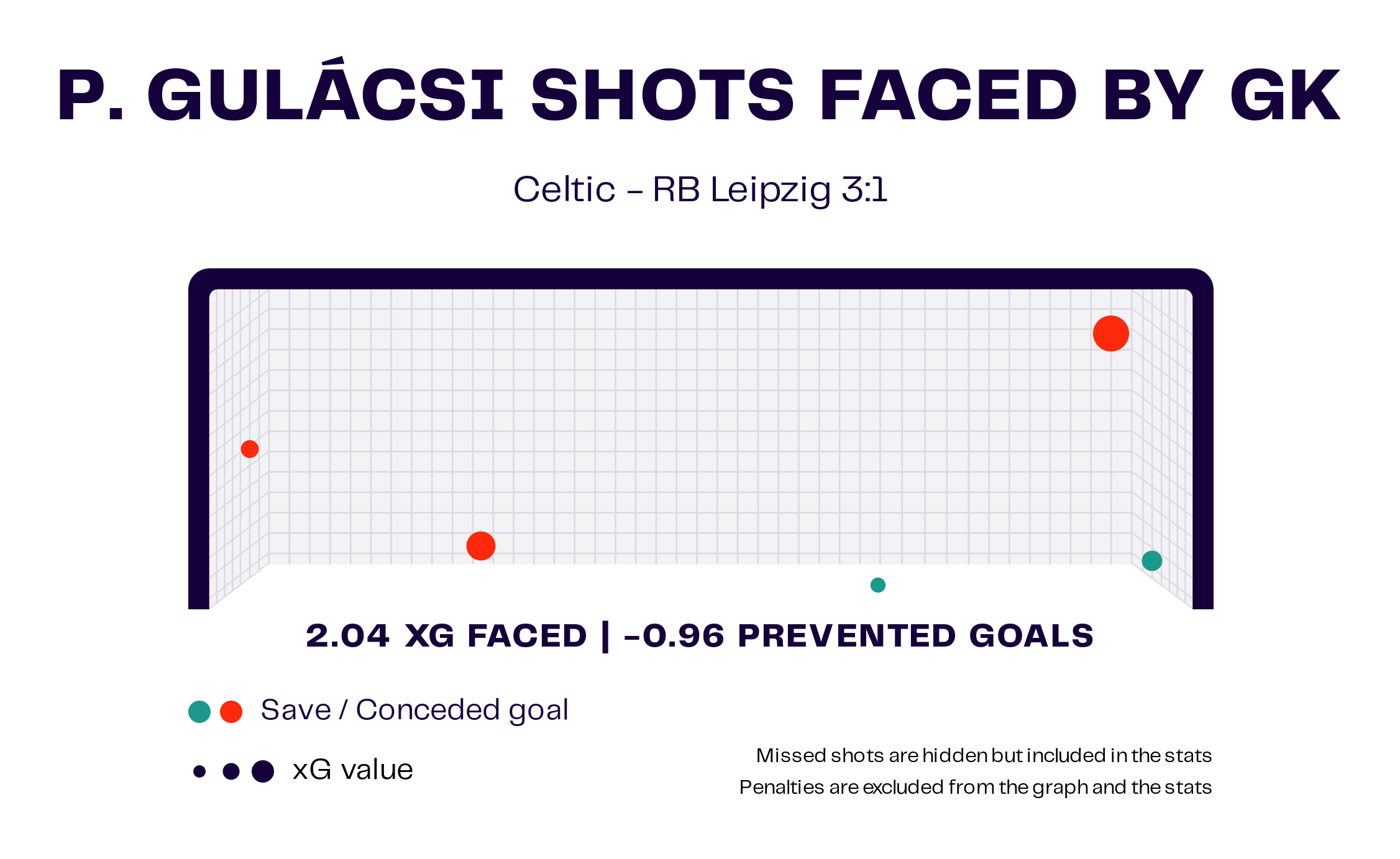
Kampl, the midfield anchor, has sometimes been overrun by more dynamic opponents, which has impacted his ability to control the game.
RB Leipzig’s tactics are becoming less effective.
Their high-pressing style requires a lot of energy and precision, which can be risky.
Teams that know how to break the press, like Dortmund and Celtic, haven’t struggled against Leipzig.
Key Players
Nicolas Kühn’s performance was undoubtedly the highlight of the night.
As a former Leipzig youth player, he had a point to prove, and he delivered with two goals and several key plays.
His first goal, a curling strike from outside the box, was a moment of brilliance that brought Celtic back into the game.
This goal, with an xG value of 0.03, was a low-probability effort, but Kuhn’s technique and precision left the Leipzig keeper with no chance.
Kuhn’s second goal demonstrated his composure and awareness in the box.
In first-half injury time, Celtic’s intense pressing led to a Leipzig mistake, allowing Kuhn to tap in from close range.
This goal significantly boosted Celtic’s momentum, putting them in control of the game.
Kuhn displayed excellent positioning, awareness, and skill throughout the match, creating a constant threat on the right flank.
Nicolas Kühn Shots Map
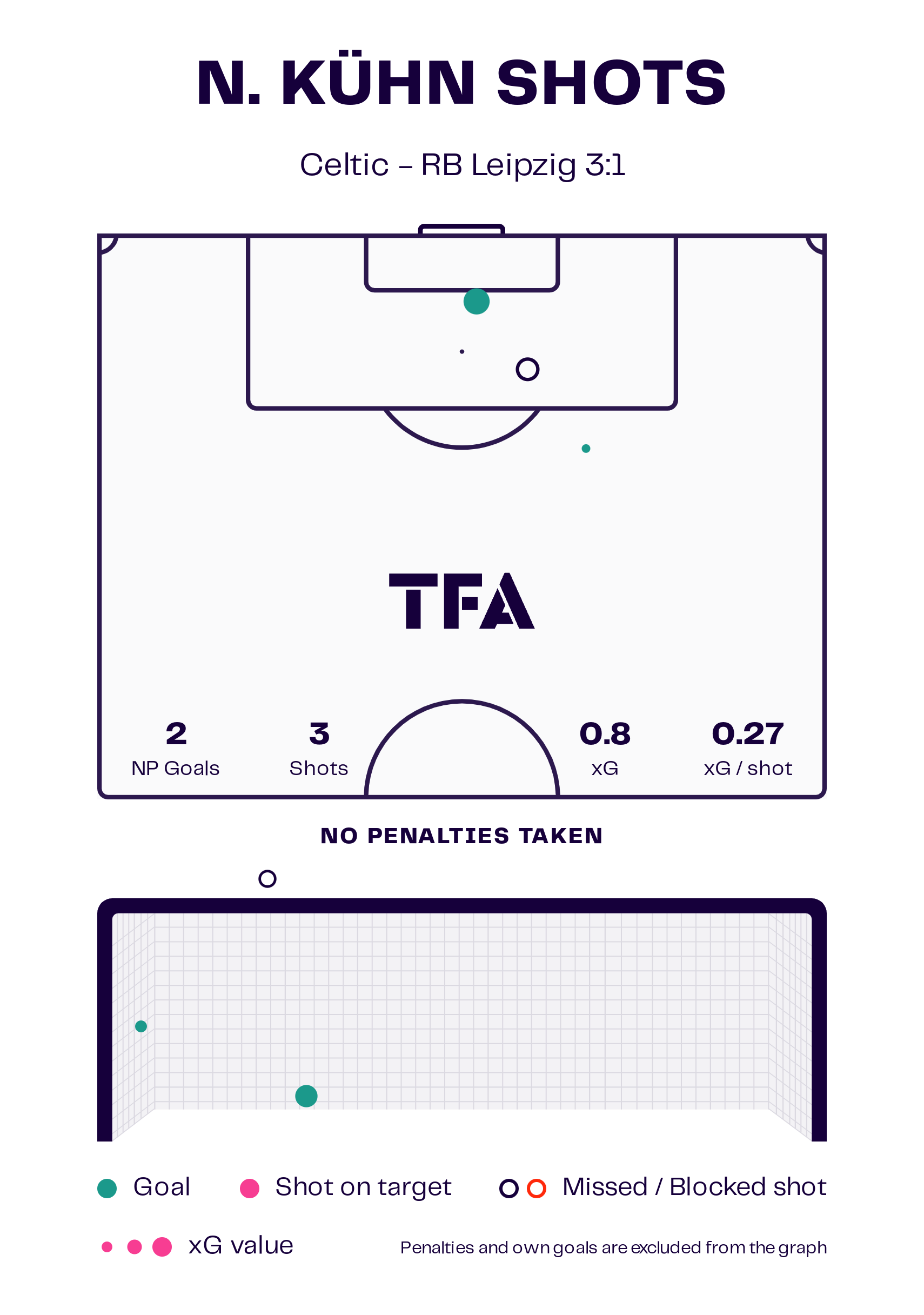
Reo Hatate was another standout player, showcasing his technical ability and high work rate.
His pressing was crucial for Celtic’s second goal, as he won the ball high up the pitch and initiated the attack that led to Kuhn’s tap-in.
Hatate was also rewarded with a goal in the 72nd minute, capitalising on a mistake by Gulacsi.
With six shots and a combined xG of 0.55, Hatate was Celtic’s most active attacker in terms of shot volume, proofing his intent to contribute offensively.
Hatate’s role as a box-to-box midfielder allowed him to impact both ends of the pitch.
He was instrumental in Celtic’s counter-pressing, winning back possession quickly and disrupting Leipzig’s rhythm.
His performance underscored his importance to Rodgers’ system and his ability to thrive in high-intensity games.
Reo Hatate Shots Map
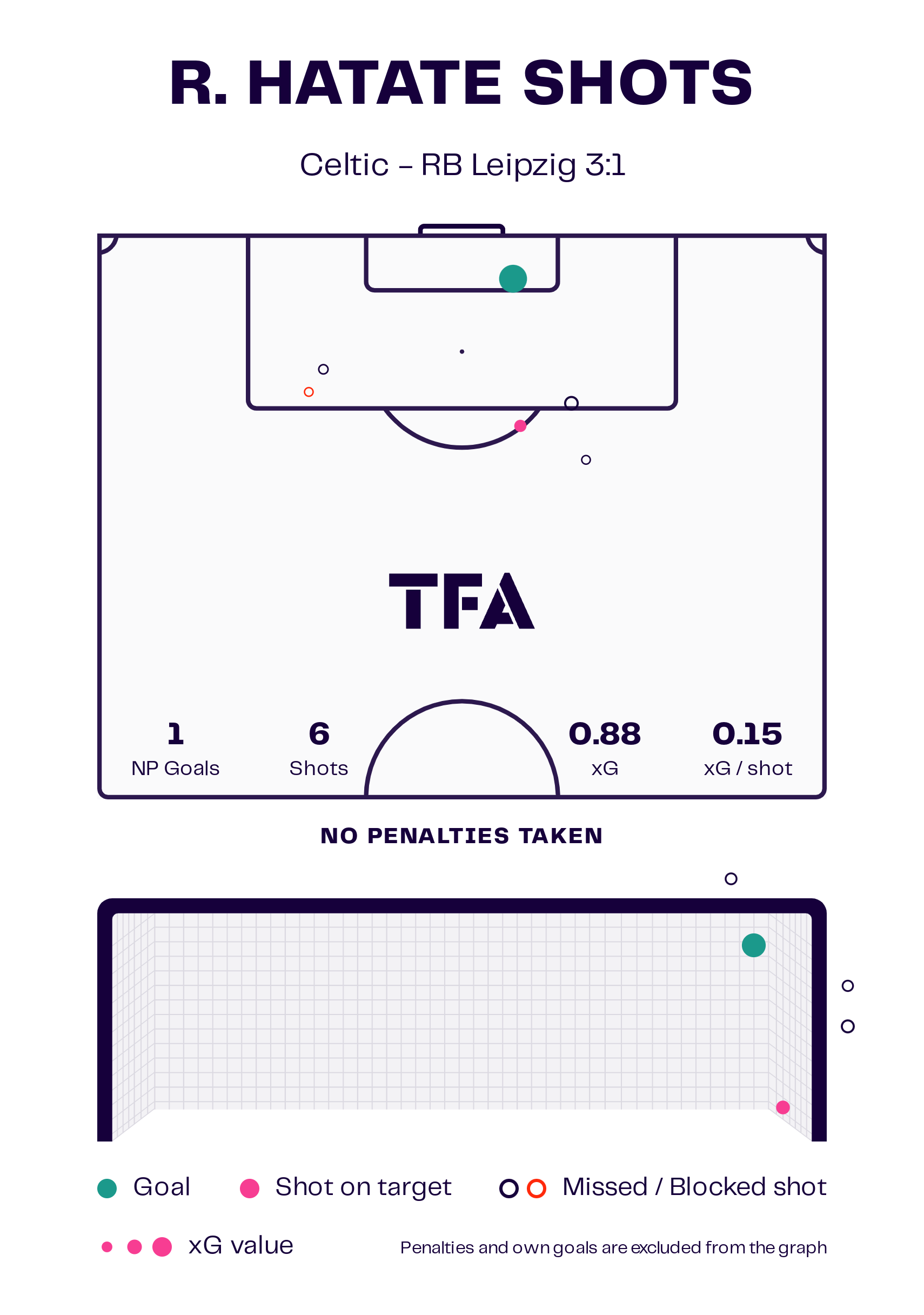
Conclusion
Celtic beat RB Leipzig 3-1.
This showed Brendan Rodgers’ skill in terms of tactics and the team’s progress in Europe.
Celtic beat Leipzig by playing well in defence, moving the ball quickly and controlling the game.
Players like Kuhn, Hatate and Trusty showed the squad is strong.
This win puts Celtic in a good position, with seven points from four games, and they can now realistically hope to reach the knockout stages.
Celtic can now compete with the best European teams.
Celtic will look to build on this performance and secure a place in the last 16.
Meanwhile, RB Leipzig’s season has been marked by inconsistency, and their recent defeats highlight systemic issues that go beyond individual games.
Leipzig’s challenges, ranging from a lack of team chemistry to recurring defensive mistakes, underperformance from veterans, and tactical inflexibility, require a holistic approach to address.
Marco Rose and his coaching staff need to consider both short-term fixes and long-term adjustments, possibly reshaping their style of play to allow for more balance and resilience.

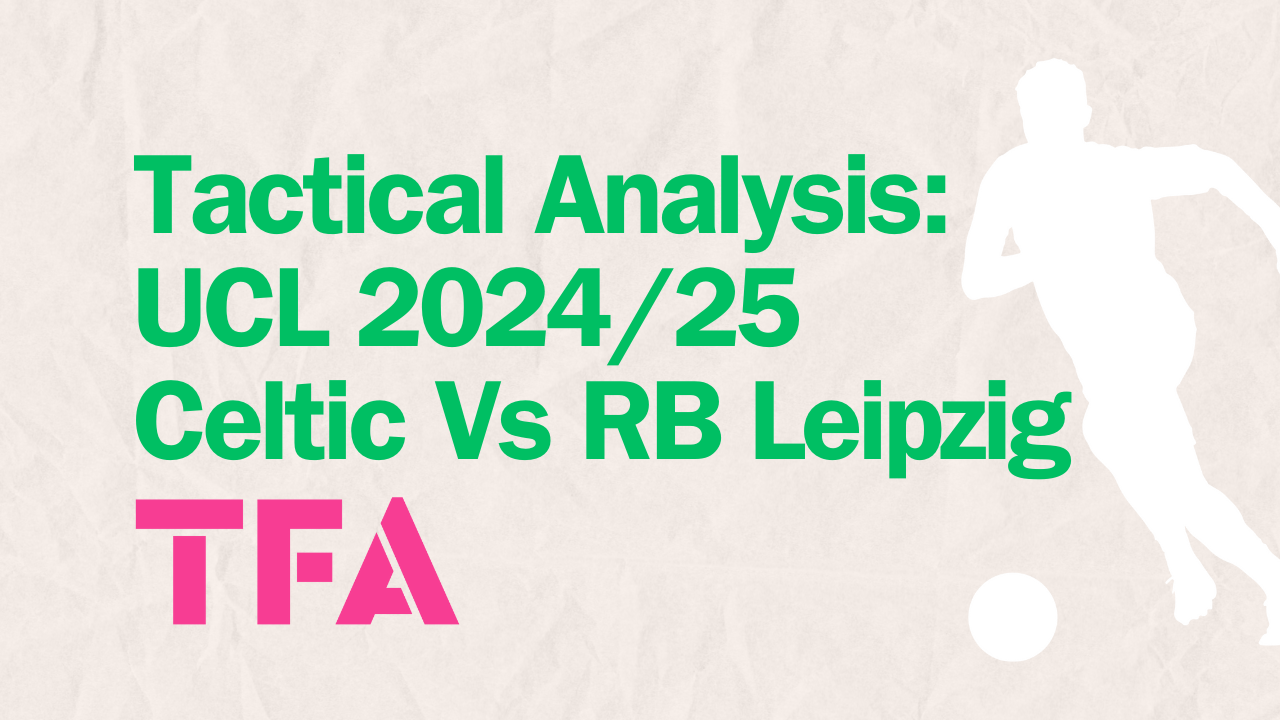



Comments